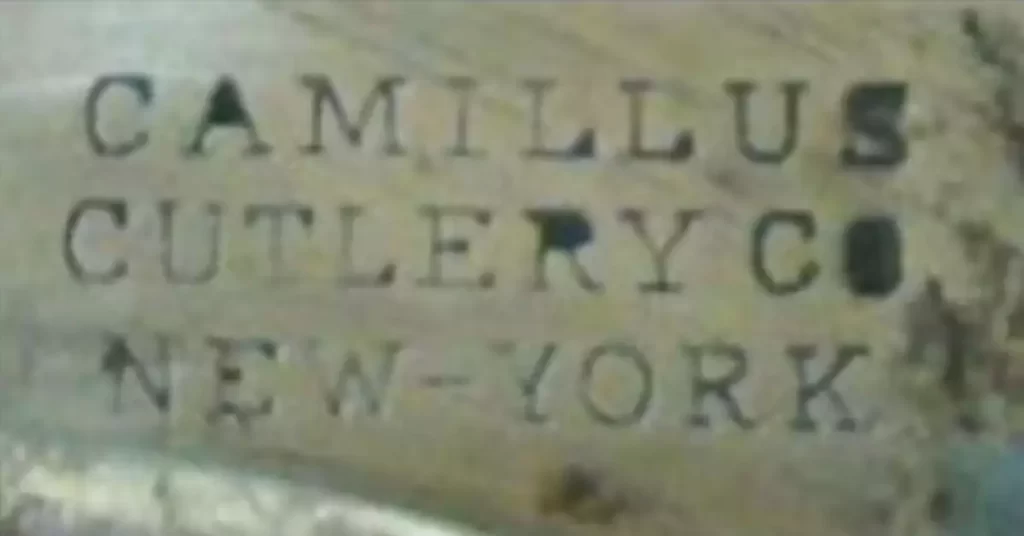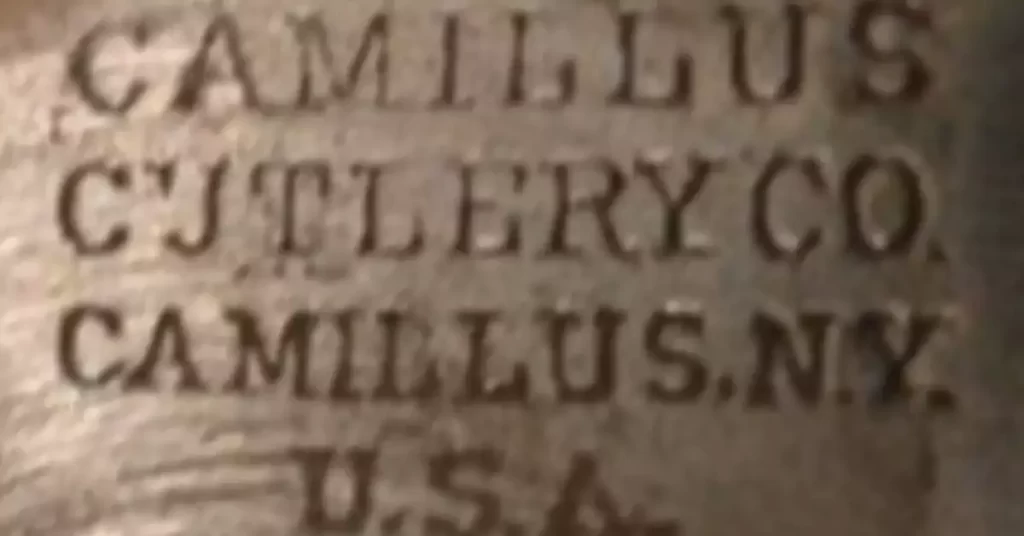Camillus knives have a rich history dating back to 1876, when Adolph Kastor founded the Camillus Cutlery Company in Camillus, New York. Over the years, Camillus knives have become synonymous with quality craftsmanship, durability, and timeless design. As a result, collectors and enthusiasts have taken a keen interest in dating their Camillus knives to understand the knife’s historical context and value.
Determining the age of a Camillus knife can be a fascinating process, involving the examination of tang stamps, handle materials, and manufacturing techniques. This article will provide a comprehensive guide on how to date your Camillus knife accurately, ensuring that you can appreciate its true value and significance.
Embarking on this journey will not only enrich your understanding of your prized Camillus knife but also deepen your appreciation for the rich heritage behind these iconic blades. So, let’s delve into the fascinating world of dating Camillus knives and uncover the secrets behind these legendary cutting tools.
Identifying the Camillus knife model
Different types of Camillus knives
Camillus produced a wide variety of knife models throughout its history, including folding pocket knives, fixed-blade knives, and military-issue knives. Some of the most popular models include:
- Scout/utility knives
- Military knives (e.g., M3 Trench Knife, M4 Bayonet, Mark 2 Combat Knife)
- Hunting and fishing knives
- Specialty knives (e.g., electrician’s knives, rope knives, and marlin spikes)
Key features to look for
When identifying the model of your Camillus knife, examine the following features:
- Blade shape and size
- Blade markings (e.g., logos, patent numbers, and model numbers)
- Handle design and materials
- Tang stamp (found on the blade near the handle)
Popular models and their distinguishing characteristics
Some popular Camillus knife models and their distinguishing features include:
- Camillus Scout/utility knives: These knives typically have a spear-point main blade, can opener, screwdriver, and a leather punch or awl. They were often used by Boy Scouts and military personnel.
- Camillus M3 Trench Knife: A fixed-blade knife with a double-edged blade and a distinctive leather handle with grooves for grip.
- Camillus Mark 2 Combat Knife: A military-issue fixed-blade knife with a clip-point blade and a stacked leather washer handle. It’s also known as the Camillus Ka-Bar, due to its resemblance to the famous Ka-Bar knife.

Understanding the Camillus tang stamp system
Evolution of tang stamps over the years
Camillus tang stamps have evolved over time, with several changes reflecting different eras in the company’s history:
- 1876-1915: “Camillus Cutlery Co.” in a straight line
- 1916-1946: “Camillus Cutlery Co. Camillus, N.Y.” in a straight line
- 1946-1970: “Camillus Cutlery Co. Camillus, N.Y.” in a curve with “U.S.A.” underneath
- 1970-1991: “Camillus New York, U.S.A.” in a curve
- 1991-2007: “Camillus U.S.A.” or “Camillus, N.Y. U.S.A.”
Decoding tang stamp elements
Tang stamps can provide valuable information for dating a Camillus knife. Key elements to look for include:
- The company name and location
- The model number or patent number (if applicable)
- Any additional markings or symbols (e.g., military markings or special edition logos)
How tang stamps can help in dating the knife
By examining the tang stamp on your Camillus knife, you can narrow down the manufacturing date to a specific time period. For instance, if your knife has the tang stamp “Camillus Cutlery Co. Camillus, N.Y.” in a straight line, you can determine that it was produced between 1916 and 1946. Furthermore, additional markings, such as military designations or patent numbers, can help refine the dating process.
Camillus knife dating based on handle materials
Common handle materials used over time
Throughout its history, Camillus used various handle materials for their knives, which can serve as clues when dating your knife:
- Bone (1876-1950s): Commonly used in the early years, bone handles were later replaced by synthetic materials.
- Stag (1876-1960s): Genuine stag handles were used on higher-end knives, with usage declining as synthetic materials became more popular.
- Celluloid (1920s-1970s): An early plastic material used extensively for handles until it was phased out due to its instability.
- Delrin (1960s-2007): A durable synthetic material that became the standard for many Camillus knives.
- Aluminum, brass, and stainless steel (1940s-2007): These materials were used for various models, particularly military-issue knives and specialty knives.
Identifying the era based on handle materials
By examining the handle material of your Camillus knife, you can determine the approximate era in which it was produced. For example, a knife with a celluloid handle would have been made between the 1920s and 1970s, while a knife with a Delrin handle would have been manufactured between the 1960s and 2007.
Notable handle material variations
In some cases, unique handle materials or variations were used for specific models or limited editions. These variations can provide additional clues for dating your Camillus knife. For example, a knife with a genuine stag handle might indicate a higher-end model from the early to mid-20th century.

Utilizing Camillus knife catalogs and advertisements
Importance of catalogs and ads in dating knives
Camillus knife catalogs and advertisements serve as valuable resources for dating your knife. These materials often contain detailed information about knife models, handle materials, blade markings, and other features that can help you pinpoint the manufacturing date of your Camillus knife.
Where to find historical Camillus catalogs and ads
You can find historical Camillus catalogs and advertisements in several places:
- Online knife forums and collector websites
- Archived publications, such as magazines and newspapers
- Books and publications dedicated to knife collecting and history
Tips on using them effectively for dating
When using Camillus catalogs and ads for dating your knife, keep the following tips in mind:
- Look for model numbers, blade markings, and handle materials that match your knife.
- Compare the features of your knife to those in the catalog or ad to ensure a proper match.
- Note any discrepancies, as they may indicate a rare variation or a misidentification.
Assessing the manufacturing quality and craftsmanship
Evolution of manufacturing techniques
Over the years, Camillus knives were produced using a variety of manufacturing techniques. Understanding these changes can help you determine the age of your knife:
- Hand-forged blades (1876-1940s): Early Camillus knives were hand-forged, resulting in unique blade shapes and grind patterns.
- Machine-made blades (1940s-2007): Advancements in manufacturing technology led to more uniform blade production, with a focus on efficiency and precision.
Identifying unique features of different time periods
By examining the craftsmanship and manufacturing quality of your Camillus knife, you can identify features that correspond to specific time periods:
- Hand-forged blades: Uneven grind lines and subtle imperfections can indicate an early Camillus knife.
- Machine-made blades: Uniform grind lines and a more polished finish suggest a later production date.
How to estimate the age based on manufacturing clues
Carefully inspect your Camillus knife for manufacturing clues that can help you estimate its age:
- Look for evidence of hand-forging, such as uneven grind lines or subtle imperfections in the blade.
- Examine the blade’s finish and overall quality to determine whether it was produced by machine or by hand.
Cross-referencing with known Camillus knife collections
Importance of comparing your knife to known collections
Cross-referencing your Camillus knife with known collections can provide valuable information about its age and authenticity. By comparing your knife to others in a collection, you can better understand its place in Camillus’s history and identify any unique features or variations.
Online resources and communities for Camillus knife collectors
Several online resources and communities are dedicated to Camillus knife collecting:
- Knife forums, such as BladeForums and iKnifeCollector
- Social media groups focused on knife collecting
- Online knife databases and reference websites
Tips on using these resources effectively
To get the most out of these resources, follow these tips:
- Provide clear photos and detailed descriptions of your knife when seeking information from others.
- Be open to feedback and suggestions, as they can help refine your understanding of your knife’s history.
- Keep records of your findings, including any supporting evidence or expert opinions.
Pitfalls to avoid while dating Camillus knives
Common misconceptions and errors
When dating your Camillus knife, be aware of these common misconceptions and errors:
- Assuming that tang stamps alone can provide an exact manufacturing date
- Misinterpreting handle materials or other features due to wear or damage
- Failing to consider rare variations or limited editions
How to avoid inaccurate dating
To avoid inaccurate dating, take these steps:
- Use multiple sources of information, such as tang stamps, handle materials, and manufacturing clues.
- Cross-reference your findings with known collections and expert opinions.
- Be open to revising your conclusions as new information becomes available.
Frequently Asked Questions (FAQs)
Can I accurately date my Camillus knife using just the tang stamp?
While tang stamps can provide valuable information, it’s essential to use additional sources, such as handle materials, manufacturing clues, and cross-referencing with known collections, to achieve accurate dating.
How can I determine if my Camillus knife is a rare variation or limited edition?
Look for unique features, such as unusual handle materials or blade markings, and consult expert opinions or known collections to help identify rare variations or limited editions.
How do I know if my Camillus knife is authentic?
Examine the tang stamp, handle materials, blade markings, and manufacturing quality to determine authenticity. Cross-reference your findings with known collections and expert opinions for additional confirmation.
Final Verdict
Dating your Camillus knife is a rewarding journey that deepens your appreciation for the rich history and craftsmanship behind these iconic cutting tools. By examining the tang stamps, handle materials, manufacturing techniques, and cross-referencing with known collections, you can accurately determine the age and authenticity of your

Terrible useless when did they use U.S CAMILLUS OR JUST CAMILLUS NY.OR US CAMILLUS N.Y..???